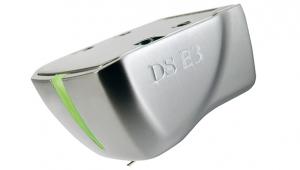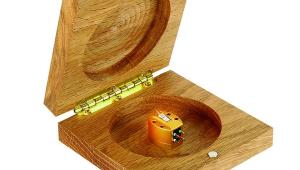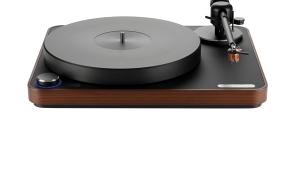EAT C-Dur
 Every product range has its sweet spot and the combination of EAT’s C-Dur deck with C-Note tonearm and optional Jo No5 moving-coil pick-up makes it the ‘plum’ choice
Every product range has its sweet spot and the combination of EAT’s C-Dur deck with C-Note tonearm and optional Jo No5 moving-coil pick-up makes it the ‘plum’ choice
Just below the mid-price point of European Audio Team’s (EAT) nine-model range, the C-Dur belt-drive deck looks likely to identify a new price/ performance benchmark. We have been flooded with decks at the £10,000-£12,000 mark to designate entry to the scary high-end, and companies such as MoFi, Thorens and Pro-Ject have numerous models from £500-£3000, but something was needed in between from, say, £3000 and £5000. At £3500 with arm, EAT’s C-Dur – German for C major – fits the bill.
Shown on these pages is the C-Dur in its high-gloss plum (wooden) finish with the 10in C-Note straight carbon-fibre tonearm, also available with the Jo No5 moving-coil cartridge, all in for £4798. As noted in the box-out, a variant with a black satin finish is offered too, while the future promises more. Whatever else may become available, this is one of the best-looking minimalist turntables I’ve seen, especially at the price.
All You Can Eat
By minimalist, I’m referring to the layout or now-generic look that dates back a half-century to Rega’s original Planar 2 and 3: an unadorned rectangular slab of Bauhaus utility, the minimum number of controls, no floppy suspension. But that does not preclude a luxurious presence, and the plum C-Dur looks like a million bucks, aided by the oversized 5.2kg, 13.5in platter which makes it seem more substantial.
Arriving in a crate, the C-Dur is packed with a detailed owner’s manual which one might be tempted to ignore if a seasoned audiophile. That would be a mistake, especially when it comes to dealing with the arm’s anti-skating arrangement, because little details demand one’s attention. As an example, the rear of the deck has only a socket for the outboard ‘wall wart’ PSU – there are no RCA outputs because the arm uses a supplied cable and 5-pin DIN-style connector inserted from underneath. And you will want to connect it before you fit the platter.
Once you’ve attended to that, as the C-Dur rests on three adjustable feet (which provide some isolation), the deck is simple to level. You then fit the sub-platter and the round cross-section belt over the pulley, followed by the main platter/spindle assembly. As this deck provides two electronically-controlled speeds, it is not necessary to remove the platter to change between them, as is the case with EAT’s less costly turntables.
Supplied with the C-Dur is a felt mat, and I ran it strictly as supplied: no tweaky mats, no pucks. Indeed, I went beyond that as I used the company’s E-Glo phono stage and E-Glo I integrated amp, so cables aside, it was an all-EAT system from source to amplifier output.
Grease Is The Word
As for the familiar C-Note tonearm [HFN Feb ’15], it was conceived to combine the advantages of a unipivot with the stability and ease-of-adjustment of conventional gimbal bearings. Available in 9, 10 and 12in lengths, its tube is carbon fibre, chosen for rigidity, while the headshell is aluminium. Inside the tonearm is a special silicon-based grease to dampen any resonances ‘by more than 50%’ according to the company.
The arm is a dream to adjust bar one aggravating detail. In most respects, the arm addresses convention with an adjustable counterweight for tracking force. The counterweight is a two-part affair, with a removable section to accommodate a wide range of cartridges. The headshell is slotted, VTA can be adjusted by loosening two set screws that grip the pillar, and azimuth can be adjusted via a removable nut at the top of the pivot.
Where I issued a litany of ‘@$%£$!&*£’ came with the hanging-thread anti-skating arrangement. A pivoting rod on the platter side of the pillar supports a weight which must be connected via a nylon filament to a barely accessible, knurled screw head on the other side of the pillar, snaked around it in a channel. I recommend fitting this before you do anything else, so you can tip the deck at an angle to work it in place.
Cleverly fitted into the three soft-touch buttons which select 33.3rpm, 45rpm or standby are LEDs to show state of play. Standby glows green when neither speed is selected. Press 33 or 45 as needed and blue LEDs indicate the selection, flickering until the speed is achieved.

























































